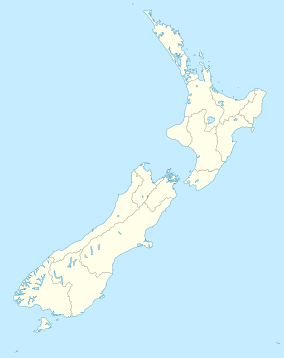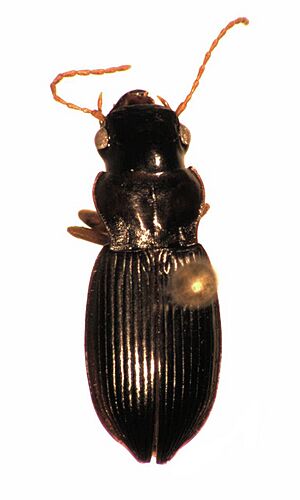Pureora Forest Park facts for kids
Quick facts for kids Pureora Forest Park |
|
|---|---|

Pureora Forest Park
|
|
| Location | North Island, New Zealand |
| Nearest city | Rotorua |
| Area | 75,957 hectares (187,690 acres) |
| Established | 1978 |
| Governing body | Department of Conservation |
Pureora Forest Park is a huge special place in the North Island of New Zealand. It covers about 760 square kilometers (about 293 square miles). This park is full of amazing rainforests. You can find many ancient trees here, some are even 1,000 years old! These trees are called podocarps.
People say Pureora Forest Park is "one of the finest rainforests in the world." It was created in 1978 after many protests. People even sat in trees to stop logging! This park is one of the biggest areas of native forest left in the North Island. It's super important for protecting many different plants and animals. New Zealand's biggest totara tree is also found nearby.
Contents
History of Pureora Forest Park
In the late 1970s, people protested against cutting down trees in what is now Pureora Forest Park. Important conservation activists like Stephen King and Shirley Guildford led these protests. They had a clever way to protest: they built platforms high up in the trees and sat on them. This was called "tree sitting." It stopped the logging machines from working.
Their efforts had three big results:
- The park was officially created in 1978.
- The Government of New Zealand changed its rules. They agreed to stop logging in these forests forever.
- A group called the Native Forest Restoration Trust was formed. This group helped the park grow and become what it is today.
One area of pine trees was replanted with native trees. Shirley Guildford worked very hard on this project. After she passed away in 1987, this special area was named the "Shirley Guildford Grove" in her memory.
Exploring the Geography of Pureora
Pureora Forest Park is located between the Rangitoto Range and Hauhungaroa Range mountains. It sits between Lake Taupo and Te Kuiti. You can get to the park from State Highway 32, which is west of Lake Taupo.
There are several tall peaks inside the park:
- Mount Pureora is 1,165 meters (3,822 feet) high.
- Mount Titiraupenga is a rocky peak, 1,042 meters (3,419 feet) high.
- Mount Pukeokahu is 844 meters (2,769 feet) high.
These mountains are popular for bike riding and hiking. Many people use the trails to reach the top of the peaks.
Inside the park, you'll find Waihora Lagoon and Waihora Stream. The Okahukura Stream is east of Okahukura Road. You can also see the Waipa Mires (wetlands) from Select Loop Road. The park has several valleys, like the Mangakahu Valley and the Tunawaea Valley. The Maramataha Valley is in the southwest. The Maramataha River nearby can be dangerous when the water is high.

In 1983, a hidden, ancient forest was found buried in the park. It was covered by pumice (a type of volcanic rock) after the Taupo volcano erupted around 186 AD. You can still see how the large tree trunks fell in rows after the eruption.
Amazing Plants and Animals (Fauna and Flora)
At lower parts of the park, you'll see tawa trees and tree ferns. There are also very tall native trees like kahikatea, matai, miro, rimu, and totara. These giant trees can grow 40–60 meters (130–200 feet) tall! They belong to an ancient family of trees that lived during the time of dinosaurs.
The Pouakani Totara tree is the tallest totara tree ever recorded in New Zealand. It's just outside the park in the Wairapara Moana Incorporation reserve. Higher up in the park, you'll find kamahi trees and Hall's totara. Near the peaks, there are many sub-alpine herbs. Grasses like toetoe also grow in the park.
The park is home to many native birds. These include the rare North Island kokako and the kaka. You might also see kakariki (parrots), kuku (also called kereru, a native pigeon), and the North Island robin.
Some animals that are not native to New Zealand, like the invasive house mouse, live in the park. Sika deer have been seen in the park, but they are not supposed to be there. Wild pigs are also present. Other animals like possums and goats are managed by park rangers to protect the native plants and animals.
Fun Things to Do in Pureora Forest Park
Pureora Forest Park is a great place for outdoor activities! You can go camping, have picnics, and swim. Mountain biking is very popular, especially on the Timber Trail, which opened in 2013. Since 1987, there has also been a Pureora Forest Park Hunting Competition.
There are many interesting spots for visitors and scientists:
- The Forest Tower: This is a 12-meter (39-foot) tall tower. It's about a ten-minute walk from the Bismarck Road car park. Bird watchers love this tower because you can see birds like kuku, kakariki, and kaka from here.
- The 1978 Treetop Protest Site: You can still visit the platforms high in the trees where the protests happened in 1978.
- Old Logging Equipment: You can see a steam hauler from the 1940s. This machine was used to pull logs through the forest. There's also a 2-tonne Caterpillar tractor from the 1950s. This tractor was used to cut down many totara trees for fence posts.
Images for kids
-
Podocarpus totara found in Pureora Forest Park







